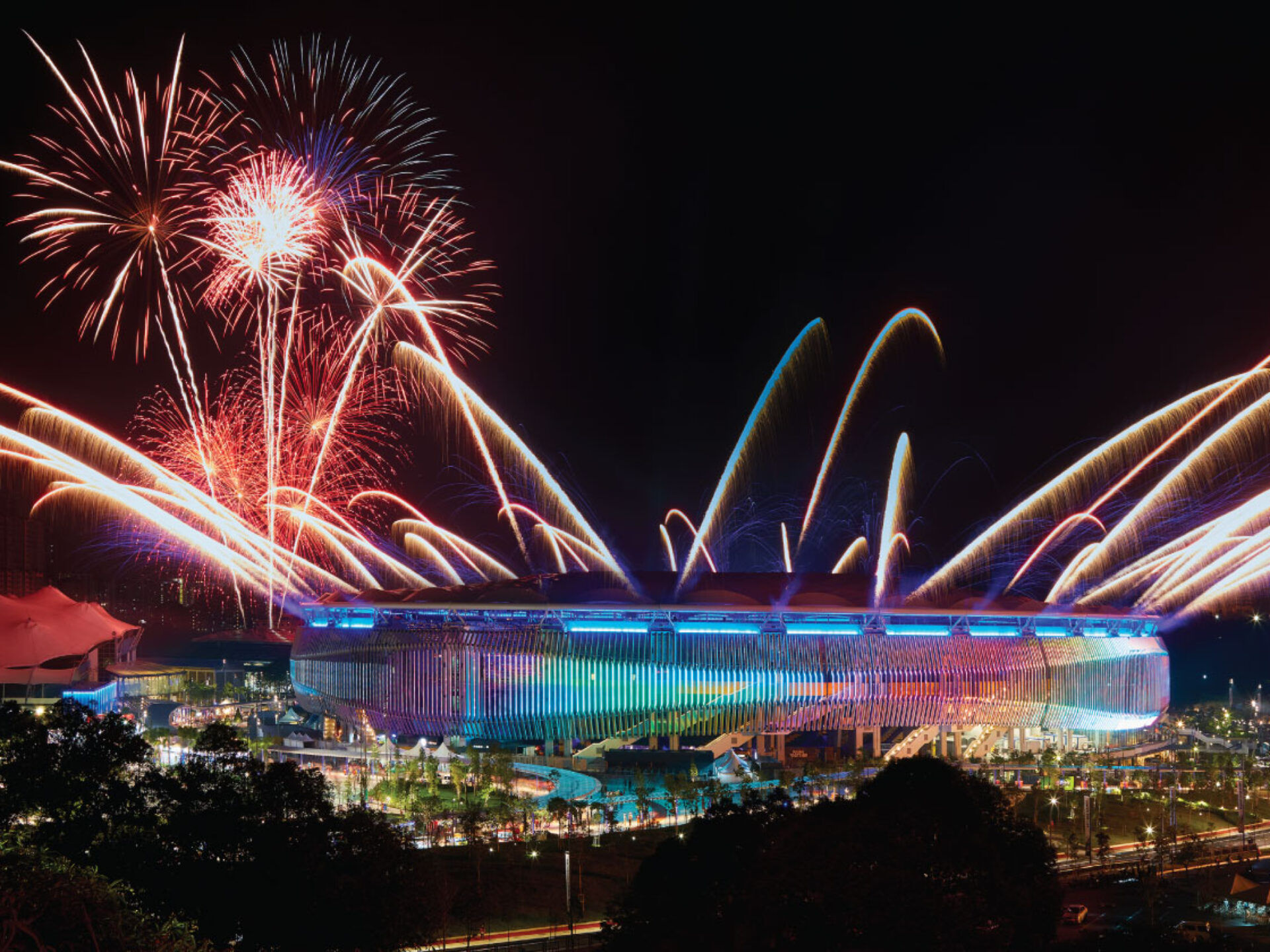May 12, 2017
KL Sports City Rejuvenated And Ready To Host The South East Asian Games

The rejuvenated and world class sporting complex that is KL Sports City at Bukit Jalil is ready for the South East Asia (SEA) Games. It has the seal of approval from the Malaysian Prime Minister, Datuk Seri Najib Tun Razak, who joined Populous Senior Principal, Paul Henry, on a tour of the complex earlier this month. Prime Minister Najib, his Sports Minister and other officials were visibly impressed, and commented on the beauty of the venue and its attraction for several national football clubs. “This will give inspiration to our athletes and develop the sports industry”, the Prime Minister tweeted.

KL Sports City is set to be the focal point for this year’s SEA Games, taking place between the 19th and the 31st of August, 2017. Known as Kuala Lumpur 2017 (KL2017), the Games will return the precinct to the world stage as the first major event to be held within the revitalised and upgraded complex.
Populous and MRCB, a leading Malaysian urban property and infrastructure company, worked together on KL Sports City with a shared vision for the precinct’s redevelopment. Originally opened in 1998 for the Commonwealth Games, the upgrade and transformation provides an exciting, world class venue for sporting excellence.
The team also considered the project to be a very special opportunity to create a co-ordinated and liveable sports city by adapting, updating and linking the existing facilities, effectively placing sport and recreation at the centre of family life, giving the community a sustainable sporting precinct year-round.
Paul Henry defines KL Sports City as “the new heart for sport and entertainment in Malaysia”. The redesign of Bukit Jalal National Stadium, Putra Stadium, the National Aquatic Centre and the National Hockey Stadium has focused on providing functional excellence of international standing. Coupled with this has been the quest to express and celebrate the Malaysian culture.

“The National Stadium is uniquely Malaysian, and will be instantly recognisable when viewed from around the world. Populous has approached the design in a bespoke manner, delivering a facility that is dynamic, distinctive, representative of the sports that are occurring in there, and evocative of Malaysia’s national identity,” Paul said.
“While we conceived the distinguishing stripes of the external façade as a reference to the Malaysian Tiger, it’s important and valuable that people can create their own stories, interpretations and nicknames over time – representative of their relationship and beloved view of these buildings,” Paul said.

Leading project architect on KL Sports City, Principal Brett Wightman believes that the developers, MRCB, have achieved extraordinary purpose in constructing these buildings within a short timeframe and on budget.
“MRCB’s approach to a co-ordinated master plan ensures that KL Sports City becomes a living centre with seven day-a-week usage. Together, MRCB and Populous have taken an old set of facilities, and re-envisaged them to be modern, exceptional buildings that can attract and host international events.


And while we focussed on the sports park, from the outset we have also designed the residential and the commercial needs to build a genuine legacy of facilities in a prime Kuala Lumpur position,” Brett said.
When the precinct hosts KL2017, it will mark the end of the first stage of the creation of a fully integrated sports hub. Stage Two which commences in early 2018, will include serviced residential, retail and commercial facilities such as a convention centre, youth hostel, park, library and sports museum, creating a modern and liveable city at Bukit Jalil.
KL SPORTS CITY FACTS SHEET: VENUE UPGRADES STAGE 1, MAY 2017
Bukit Jalil National Stadium
The largest stadium in South East Asia, Bukit Jalil can seat 87,000 people and has previously held major events including the 1998 Commonwealth Games, the 2007 Asian Cup (soccer) and exhibition matches with Manchester City, Liverpool, Arsenal and Chelsea.
The re-designed Stadium features:
- A unique façade made from a series of vertical louvers that have been twisted in response to climatic conditions: offering sun shading and encouraging natural ventilation to the concourse without completely obscuring the original iconic skeleton of the stadium
- LED lights have been integrated into the louvers, allowing digitally based animations, advertisements and branding to flow over the 3 dimensional façade
- The comprehensive upgrade of facilities, infrastructure and systems
- Upgraded and reconsidered hospitality and corporate
- Greatly improved and modernised fan experience and community hub facilitation
Axiata Arena (formally named Putra Stadium)
Recently renamed Axiata Arena, the well-known Putra Indoor Stadium has 11,000 permanent and 2,232 retractable seats, making it a flexible space for indoor sports and events. Among many others, the venues has hosted boxing, badminton, basketball table tennis and judo with major events such as WWE, Disney Ice, the 2009 ASEAN Para Games and concerts from Taylor Swift, to Michael Bublé and Alicia Keys.
The upgrades include:
- New Contemporary Façade to cover the existing building and offer a new lobby and entrance space
- Complete replacement of all seats and a new retractable seating platform
- New suites and corporate facilities which increases the number of corporate and VIP seating to 500, allowing the venue to attract bigger name artists and generate greater revenue.
- Upgrades to all the toilets and changing room facilities
- Installation of advanced fire protection systems that comply with global safety standards
- New air conditioning system, sports lighting and PA system
National Aquatic Centre
Comprising Olympic standard swimming pool, warm-up areas and diving pool, the Aquatics Centre has a distinct shaded fabric roof, open to natural ventilation with views to the landscape beyond.
The recent redesign and upgrades include:
- New distinct façade offering a generous shaded entrance space with a fabric roof and glass curtain wall to allow more daylight into the building
- A replacement of the existing fabric roof at the seating and pool area
- New FINA compliant diving board
- Upgrades to the VIP lobby space, changing rooms and media facilities, public toilets
- New sports lighting and PA systems
- New tiling, underwater lighting and mechanical filtration systems to all the pools
National Hockey Stadium
Home of the Malaysian national men’s and women’s field hockey teams, the stadium seats up to 12,000 people and has hosted matches in the 2002 Men’s Hockey World Cup, 1999 Hockey Asia Cup, 2003 Hockey Asia Cup, 1982 Hockey Junior World Cup, 2000 Hockey Junior Asia Cup and 1998 Commonwealth Games.
The recent upgrades include:
- New, world-class turf pitch
- New sports lighting
- Upgrades to all the toilets
- Installation of advance fire protection systems that comply with global safety standards.
Precinct Enhancements
- New, covered pedestrian boulevards link all stadiums and allows accessibility for wheelchair users
- Completely rejuvenated landscaping creates far more green space, including terraces which cascade from the Stadium down to the train station
- Pedestrian-centred layout aimed at encouraging public transport use and activity within the precinct even when there is not a major event on
- New cycling and running tracks to encourage community participation
- New toilets and opportunities for pop-up Food & Beverage kiosks around all three stadiums
- Improved circulation for pedestrians, service vehicles, emergency and bus access to site
- New wayfinding and signage.
Lorem ipsum dolor sit amet consectetur, adipisicing elit. Non facere corporis et expedita sit nam amet aut necessitatibus at dolore enim quis impedit eius libero, harum tempore laboriosam dolor cumque.
Lorem, ipsum dolor sit amet consectetur adipisicing elit. Illo temporibus vero veritatis eveniet, placeat dolorem sunt at provident tenetur omnis, dicta exercitationem. Expedita quod aspernatur molestias eum? Totam, incidunt quos.
